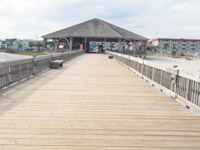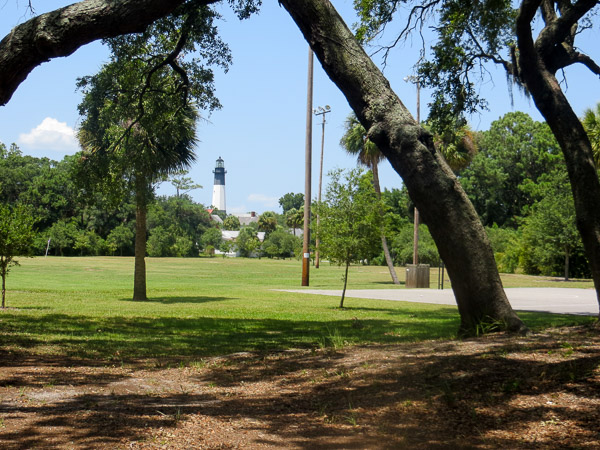 Tybee Island Pier and Pavilion
Tybee Island Pier and Pavilion
Beach, Pier and Pavilion
 Tybee Island Pier and Pavilion
Tybee Island Pier and Pavilion
Beach, Pier and Pavilion
Tybee IslandPier and Pavilio, GA 31328
The Tybee Pier & Pavilion is located just off U.S. Highway 80 at the end of Tybrisa Street. There are picnic tables, snack bar and public restrooms located on the pier. There are various events and festivals held on the pier throughout the year. It is open daily with free admission. The Tybee Beach Pier and Pavilion is a great place for fishing.
The original Tybrisa Pier & Pavilion was built in 1891 and stood for three-quarters of a century as a landmark on the South Atlantic Ocean but in 1967 fire destroyed it. The new pier and pavilion was built in August 1996.
]]> Coastal Georgia Botanical Gardens
Coastal Georgia Botanical Gardens
Coastal Georgia Botanical Gardens
 Coastal Georgia Botanical Gardens
Coastal Georgia Botanical Gardens
Coastal Georgia Botanical Gardens
Savannah, GA 31419
Hours:
Monday - Friday: 8:00a - 5:00p
Saturday: 10:00a - 5:00p
Sunday: 12:00p - 5:00p
The Coastal Georgia Botanical Gardens are 16.5 miles, 22 minutes from River Street via I-16 West, I-95 South and then Hwy. 25 East. The Gardens is a former USDA plant-introduction station that has developed into a 51-acre botanical garden. It is located at 2 Canebrake Road, Chatham County, Georgia, south of Savannah. Still known by many Savannahians as "The Bamboo Farm" (a name that dates from the 1940s), the botanical garden is open daily, except holidays, and no entrance fee is required.
]]> Cockspur Island
Cockspur Island
Cockspur Island
 Cockspur Island
Cockspur Island
Cockspur Island
Tybee Island, GA 31328, GA 31328
Cockspur Island is located in the south channel of the Savannah River near Lazaretto Creek, northwest of Tybee Island, Georgia. Most of the island is within the boundaries of Fort Pulaski National Monument.
Historic buildings on the island include Fort Pulaski and the Cockspur Island Lighthouse. During the Spanish–American War, a coastal artillery battery, Battery Hambright, was built on the island; it was reactivated during World Wars One and Two.
The founder of Methodism, John Wesley landed at the island on February 6, 1736 and a monument marks the spot where Wesley conducted a service of thanksgiving
]]> Cockspur Island Light
Cockspur Island Light
Cockspur Island Light
 Cockspur Island Light
Cockspur Island Light
Cockspur Island Light
Tybee Island, GA 31328
The Cockspur Island Light is the smallest lighthouse in Georgia located in Chatham County, Georgia. The Cockspur Island Light is located on an islet off the southeastern tip of Cockspur Island. The Cockspur Lighthouse is stands twelve miles east of the port of Savannah. The islet is comprised of oyster shells, and marsh grass and is often covered by high tide.
In 1837 Cockspur Island Light was originally built as a daymarker and in 1848 it was retrofitted with lights and reflectors. In 1855 the Cockspur Island Light was replaced due to hurricane damage and was later built on the same foundation. The Cockspur Island Light is 46 feet high.
On June 1, 1909, the light was finally extinguished, because the south channel was infrequently used, compared to the deeper and wider North Channel of the Savannah River. On March 18, 2007 the lighthouse was relit for historical purposes.
The lighthouse remains open to the public, though access is limited by the terrain of Cockspur Island. However, an overlook trail offers visitors the best chance to get a closer look at the lighthouse today.
]]> Fort Jackson
Fort Jackson
Fort Jackson
 Fort Jackson
Fort Jackson
Fort Jackson
Savannah, GA 31401
Hours:
Sunday - Saturday 9:00a - 5:00p
Built in 1808 to protect Savannah from foreign attack, Fort Jackson survived the War of 1812 and the Civil War and is now a popular historic site. It stands on the banks of the Savannah River.
Originally built of earth, faced with brick and topped with a gun platform of wood, the battery in its day was one of the strongest fortifications in the United States. After the War of 1812, two periods of construction followed at the fort. A moat, drawbridge, brick barracks, privies, a rear wall, and another powder magazine were added.
{jssocials}]]> Fort Pulaski
Fort Pulaski
Fort Pulaski
 Fort Pulaski
Fort Pulaski
Fort Pulaski
Savannah, GA 31401
Hours:
Daily 8:30a - 5:15p
Hours may be extended in summer.
A massive five-sided edifice, Fort Pulaski was constructed in the 1830s and 1840s on Cockspur Island at the mouth of the Savannah River to protect the city of Savannah from naval attack.
Following the War of 1812, U.S. President James Madison ordered a new system of coastal fortifications to protect the United States against foreign invasion. Construction of a fort to protect the port of Savannah began in 1829 and was named for Count Casimir Pulaski, a Polish immigrant who fought during the American Revolution.
{jssocials}]]> Fort Screven
Fort Screven
Fort Screven
 Fort Screven
Fort Screven
Fort Screven
Tybee Island, GA 31328
Tickets:
Adults: $9.00
Seniors (62+), Military with ID and Children: $7.00
Members of the U.S. Coast Guard and Kids 5 and under are admitted free.
Note: The last tickets are sold at 4:30 p.m. and can be purchased at the Tybee Island Lighthouse across the street from Battery Garland.
Fort Screven was built around 1875 at the North end of Tybee Island. The fort has a maganificent view of the Atlantic and the Savannah River.
Fort Screven had seven batteries, six on Tybee Island and a seventh, Battery Hambright, near Fort Pulaski. Battery Garlandnow houses the Tybee Island Museum and is open to the public, as is Battery Hambright. The others can be seen from the street and beach, but are not publicly accessible.
]]> Jaycee Park
Jaycee Park
Jaycee Park
 Jaycee Park
Jaycee Park
Jaycee Park
Tybee Island, GA 31328
Jaycee Park covers 8.5 acres and has many species of wildlife, variety of plant life, and marshy creeks. Jaycee Park is located at the intersection of Campbell Rd. on Van Horne, within walking distance of the beach. There is a 1/4 mile track through the area to enable you to walk or take a bicycle. Small bridges cross the creek, and a few gazebos are scattered, as well as picnic tables. There is also a lighted ball field, practice field, basketball court, playground, recreation building, parking lot, and public restrooms.
]]> Little Tybee Island
Little Tybee Island
Little Tybee Island is located south of Tybee Island, Georgia. Little Tybee Island is 6,780 total acres including marsh. It is home to a number of endangered species of birds.
]]>
 Savannah Botanical Gardens
Savannah Botanical Gardens
Savannah Botanical Gardens
 Savannah Botanical Gardens
Savannah Botanical Gardens
Savannah Botanical Gardens
Savannah, GA 31406
Hours:
Monday - Sunday: 7:30a - 5:30p
Savannah Botanical Gardens is owned and operated by Savannah Area Council of Garden Clubs, Inc. The site was designed and created in the late 1980's as an all volunteer effort. The garden includes both formal and naturalistic plantings as well as a two acre pond, amphitheater, nature trails, archaeological exhibit and the historic Reinhard House.
]]>